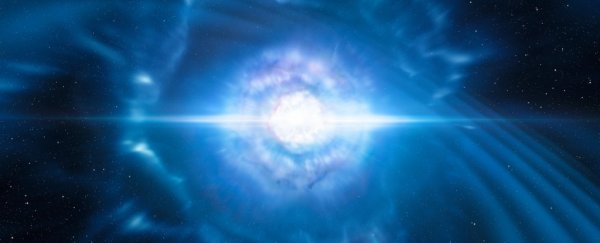When astronomers around the world watched two neutron stars collide in August 2017, it taught us a whole lot of cool things about the Universe. Now there's one more cool thing: Astronomers have used it to refine one of the most fundamental characteristics of the entire Universe - the Hubble Constant.
The Hubble Constant is the name given to the rate at which the Universe is expanding, and discrepancies in this measurement have been giving cosmologists grief for some time.
You see, according to data from the Planck satellite that measured the cosmic microwave background (the conditions of the early Universe just 380,000 years after the Big Bang), the Hubble Constant should be 67.4 kilometres (41.9 miles) per second per megaparsec.
That's one method to measure it.
Another is by studying the nebulae left behind by Type Ia supernovae. Way back when, Edwin Hubble observed their Doppler shift - that is, the changes in the wavelength of light as the nebula moves farther away. This method recently returned a result of 72.78 kilometres per second per megaparsec.
Yet another, more recent method uses standard candles such as Cepheid variable stars, whose known luminosity allows for accurate distance calculations. And this is where trouble strikes - because these measurements turn in a faster Hubble Constant.
Most recently, a measurement based on the motions of 70 Cepheid variables returned a result of 74.03 kilometres per second per megaparsec. So, you see the dilemma.
"Either one of them is incorrect, or the models of the physics which underpin them are wrong. We'd like to know what is really happening in the Universe, so we need a[n] … independent check," said astrophysicist Adam Deller of Swinburne University of Technology.
"The merger of two neutron stars is such a third way."
Cue GW170817, the gravitational wave event that allowed, for the first time, astronomers around the world to observe a collision between two neutron stars in multiple ways - including gravitational wave astronomy, optical astronomy, and radio astronomy.
" Neutron star mergers are phenomenally energetic events – two stars each more massive than our Sun whip around each other hundreds of times per second before merging and producing an enormous blast of material flung outwards at immense speed, as well as a burst of gravitational waves," Deller explained.
"This burst of gravitational waves can be used as a 'standard siren': based on the shape of the gravitational wave signal, we can tell how 'bright' the event should have been in gravitational waves. We can then take how bright the event was actually seen to be, and work out what the distance must have been."
However, this can only be done if we know the orientation of the collision. For that, we need more data than just the event itself.
That came in the form of the narrow, collimated jet of plasma ejected from the collision, observed over time by radio telescopes. And they found that it had what is known as superluminal motion; that is, when something appears to be moving faster than light-speed, based on the angle at which we are observing it.
By comparing tiny changes in the location and shape of this plasma, the team were able to calculate the orientation of the neutron stars - which, in turn, allowed them to calculate its precise distance.
The collision occurred in a galaxy 130 million light-years away, and the good thing here is that we know the speed at which this galaxy is travelling away from us. So, when the team compared the distance of GW170817 to the speed of the galaxy, they were able to derive the Hubble Constant.
The figure they ended up with was 70.3 kilometres per second per megaparsec.
As you can see, between the Planck measurement and the standard candle measurements, we're in the right ballpark at least - even if the new measurement isn't quite certain enough to tell us whether Planck, supernovae, or Cepheid variables are more accurate.
"But," Deller said, "we showed that in the near future, observations of more merging neutron stars will be able to make that discrimination."
The paper has been published in Nature Astronomy.
